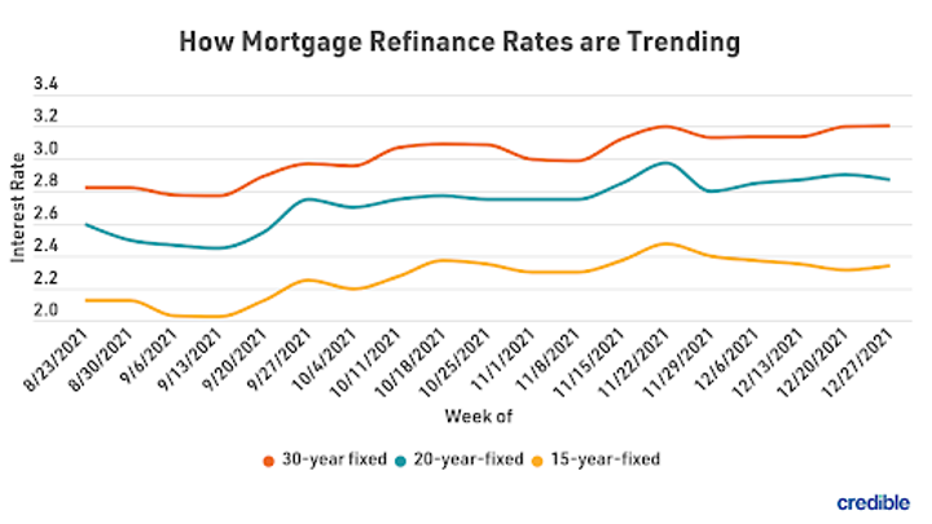30-year mortgage refinance rates dip slightly to start 2022 | Jan. 3, 2022
Our goal here at Credible Operations, Inc., NMLS Number 1681276, referred to as "Credible" below, is to give you the tools and confidence you need to improve your finances. Although we do promote products from our partner lenders, all opinions are our own.

Check out the mortgage refinancing rates for Jan. 3, 2022, which are largely unchanged from last week. (iStock)
Based on data compiled by Credible, current mortgage refinance rates largely remained stable, except for 30-year rates which dipped incrementally.
- 30-year fixed-rate refinance: 3.190%, down from 3.250%, -0.060
- 20-year fixed-rate refinance: 2.875%, unchanged
- 15-year fixed-rate refinance: 2.375%, unchanged
- 10-year fixed-rate refinance: 2.250%, unchanged
Rates last updated on Jan. 3, 2022. These rates are based on the assumptions shown here. Actual rates may vary.
Today’s dip in 30-year mortgage refinance rates gives homeowners an opportunity to lock in what could be one of the lowest rates of the year for this repayment term. Mortgage experts widely predict rates will continue to rise in 2022. Homeowners looking to pay off their mortgages sooner while scoring an even lower rate may find 20-year mortgage refinances particularly appealing today — rates for this term have held at 2.875% for six consecutive days.

These rates are based on the assumptions shown here. Actual rates may vary.
If you’re thinking of refinancing your home mortgage, consider using Credible. Whether you're interested in saving money on your monthly mortgage payments or considering a cash-out refinance, Credible's free online tool will let you compare rates from multiple mortgage lenders. You can see prequalified rates in as little as three minutes.
Current 30-year fixed refinance rates
The current rate for a 30-year fixed-rate refinance is 3.190%. This is down from last week. Refinancing a 30-year mortgage into a new 30-year mortgage could lower your interest rate, but may not have much effect on your total interest costs or monthly payment. Refinancing a shorter term mortgage into a 30-year refinance could result in a lower monthly payment but higher total interest costs.
Current 20-year fixed refinance rates
The current rate for a 20-year fixed-rate refinance is 2.875%. This is the same as last week. By refinancing a 30-year loan into a 20-year refinance, you could secure a lower interest rate and reduce total interest costs over the life of your mortgage. But you may get a higher monthly payment.
Current 15-year fixed refinance rates
The current rate for a 15-year fixed-rate refinance is 2.375%. This is the same as last week. A 15-year refinance could be a good choice for homeowners looking to strike a balance between lowering interest costs and retaining a manageable monthly payment.
Current 10-year fixed refinance rates
The current rate for a 10-year fixed-rate refinance is 2.250%. This is the same as last week. A 10-year refinance will help you pay off your mortgage sooner and maximize your interest savings. But you could also end up with a bigger monthly mortgage payment.
You can explore your mortgage refinance options in minutes by visiting Credible to compare rates and lenders. Check out Credible and get prequalified today.
Rates last updated on Jan. 3, 2022. These rates are based on the assumptions shown here. Actual rates may vary.
Is now a good time to refinance?
Mortgage refinance rates have been at historic lows all year. It’s unlikely they’ll go much lower and extremely possible they’ll begin to rise in the coming months. But low rates aren’t the only factors that determine whether now is a good time for you to refinance your home loan.
Everyone’s situation is different, but generally, it may be a good time to refinance if:
- You’ll be able to get a lower interest rate than you currently have.
- Refinancing will save you money over the life of your home loan.
- Your savings from refinancing will ultimately exceed closing costs.
- You know you’ll be staying in your home long enough to recoup the costs of refinancing.
- You have sufficient equity in your home to avoid private mortgage insurance (PMI).
If your home needs significant, costly repairs it might be a good time to refinance in order to withdraw some equity to pay for those repairs. Just be aware that lenders generally limit the amount you can take from your home in a cash-out refinance.
How to get your lowest mortgage refinance rate
If you’re interested in refinancing your mortgage, improving your credit score and paying down any other debt could secure you a lower rate. It’s also a good idea to compare rates from different lenders if you're hoping to refinance so you can find the best rate for your situation.
Borrowers can save $1,500 on average over the life of their loan by shopping for just one additional rate quote, and an average of $3,000 by comparing five rate quotes, according to research from Freddie Mac.
Be sure to shop around and compare rates from multiple mortgage lenders if you decide to refinance your mortgage. You can do this easily with Credible’s free online tool and see your prequalified rates in only three minutes.
How does Credible calculate refinance rates?
Changing economic conditions, central bank policy decisions, investor sentiment and other factors influence the movement of mortgage refinance rates. Credible average mortgage refinance rates are calculated based on information provided by partner lenders who pay compensation to Credible.
The rates assume a borrower has a 740 credit score and is borrowing a conventional loan for a single-family home that will be their primary residence. The rates also assume no (or very low) discount points and a down payment of 20%.
Credible mortgage refinance rates will only give you an idea of current average rates. The rate you receive can vary based on a number of factors.
When is it worth it to refinance?
Refinancing a mortgage can be a great way to save money. But it’s not always the best move for every homeowner.
People refinance for a number of reasons, including to get a lower interest rate, change their monthly payment amount and lower their interest costs. Generally, if you can lower your interest rate by at least 0.75%, refinancing might be a good move.
Here’s an example of how refinancing can save you money: If you refinance your 30-year, $300,000 loan at 4% into a new 30-year loan with a 3.25% interest rate, you’ll lower your monthly payment from $1,432 to $1,306. That’s a monthly savings of $126, which adds up to $45,360 over the life of the mortgage.
But before you refinance, be sure to weigh closing costs, and calculate how long it will take before your savings from the refinance cover the expenses of refinancing.
Credible is also partnered with a home insurance broker. If you're looking for a better rate on home insurance and are considering switching providers, consider using an online broker. You can compare quotes from top-rated insurance carriers in your area — it's fast, easy and the whole process can be completed entirely online.
If you think refinancing is the right move, consider using Credible. You can use Credible's free online tool to easily compare multiple mortgage refinance lenders and see prequalified rates in as little as three minutes.
Rates last updated on Jan. 3, 2022. These rates are based on the assumptions shown here. Actual rates may vary.
Have a finance-related question, but don't know who to ask? Email The Credible Money Expert at moneyexpert@credible.com and your question might be answered by Credible in our Money Expert column.
As a Credible authority on mortgages and personal finance, Chris Jennings has covered topics that include mortgage loans, mortgage refinancing, and more. He’s been an editor and editorial assistant in the online personal finance space for four years. His work has been featured by MSN, AOL, Yahoo Finance, and more.

